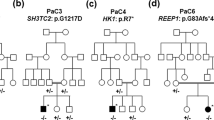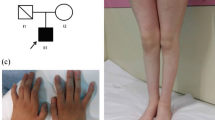Abstract
Over 40 mutations in the GDAP1 gene have been shown to segregate with Charcot–Marie–Tooth disease (CMT). Among these, only two mutations, i.e., S194X and Q163X have been reported in a sufficient number of CMT families to allow for the construction of reliable phenotype–genotype correlations. Both the S194X and Q163X mutations have been shown to segregate with an early-onset and severe neuropathy resulting in loss of ambulance at the beginning of the second decade of life. In this study, we identified the L239F mutation in the GDAP1 gene in one Bulgarian and five Polish families. We hypothesized that the L239F mutation may result from a founder effect in the European population since this mutation has previously been reported in Belgian, Czech, and Polish patients. In fact, we detected a common disease-associated haplotype within the 8q13-q21 region in the Polish, German, Italian, Czech, and Bulgarian CMT families. Like the previously detected “regional” S194X and Q163X mutations, respectively present in Maghreb countries and in patients of Spanish descent, the L239F mutation seems to be the most common GDAP1 pathogenic variant in the Central and Eastern European population. Given the likely presence of a common ancestor harboring the L239F mutation, we decided to compare the phenotypes of the CMT (L239F) patients collected in this study with those of previously reported cases. In contrast to CMT4A caused by the S194X and Q163X mutations, the CMT phenotype resulting from the L239F substitution represents a milder clinical entity with a long-preserved period of ambulance at least until the end of the second decade of life.



Similar content being viewed by others
References
Aarskog NK, Vedeler CA (2000) Real-time quantitative polymerase chain reaction. A new method that detects both the peripheral myelin protein 22 duplication in Charcot–Marie–Tooth type 1A disease and the peripheral myelin protein 22 deletion in hereditary neuropathy with liability to pressure palsies. Hum Genet 107:494–498
Ammar N, Nelis E, Merlini L, Barisic N, Amouri R, Ceuterick C et al (2003) Identification of novel GDAP1 mutations causing autosomal recessive Charcot–Marie–Tooth disease. Neuromuscul Disord 13:720–728
Azzedine H, Ruberg M, Ente D, Gilardeau C, Perie S, Wechsler B et al (2003) Variability of disease progression in a family with autosomal recessive CMT associated with a S194X and new R310Q mutation in the GDAP1 gene. Neuromuscul Disord 13:341–346
Barankova L, Vyhnalkova E, Zuchner S, Mazanec R, Sakmaryova I, Vondracek P et al (2007) GDAP1 mutations in Czech families with early-onset CMT. Neuromuscul Disord 17:482–489
Baxter RV, Ben Othmane K, Rochelle JM, Stajich JE, Hulette C, Dew-Knight S et al (2002) Ganglioside-induced differentiation-associated protein-1 is mutant in Charcot–Marie–Tooth disease type 4A/8q21. Nat Genet 30:21–22
Ben Othmane K, Hentati F, Lennon F, Ben Hamida C, Blel S, Roses AD et al (1993) Linkage of a locus (CMT4A) for autosomal recessive Charcot–Marie–Tooth disease to chromosome 8q. Hum Mol Genet 2:1625–1628
Birouk N, Azzedine H, Dubourg O, Muriel MP, Benomar A, Hamadouche T et al (2003) Phenotypical features of a Moroccan family with autosomal recessive Charcot–Marie–Tooth disease associated with the S194X mutation in the GDAP1 gene. Arch Neurol 60:598–604
Boerkoel CF, Takashima H, Nakagawa M, Izumo S, Armstrong D, Butler I et al (2003) CMT4A: identification of a Hispanic GDAP1 founder mutation. Ann Neurol 53:400–405
Bouhouche A, Birouk N, Azzedine H, Benomar A, Durosier G, Ente D et al (2007) Autosomal recessive axonal Charcot–Marie–Tooth disease (ARCMT2): phenotype–genotype correlations in 13 Moroccan families. Brain 130:1062–1107
Cassereau J, Chevrollier A, Gueguen N, Malinge MC, Letournel F, Nicolas G et al (2009) Mitochondrial complex I deficiency in GDAP1-related autosomal dominant Charcot–Marie–Tooth disease (CMT2K). Neurogenetics 10(2):145–150
Chung KW, Kim SM, Sunwoo IN, Cho SY, Hwang SJ, Kim J et al (2008) A novel GDAP1 Q218E mutation in autosomal dominant Charcot–Marie–Tooth disease. J Hum Genet 53:360–364
Claramunt R, Pedrola L, Sevilla T, Lopez DM, Berciano J, Cuesta A et al (2005) Genetics of Charcot–Marie–Tooth disease type 4A: mutations, inheritance, phenotypic variability, and founder effect. J Med Genet 42:358–365
Cuesta A, Pedrola L, Sevilla T, Garcia-Planells J, Chumillas MJ, Mayordomo F et al (2002) The gene encoding ganglioside-induced differentiation-associated protein 1 is mutated in axonal Charcot–Marie–Tooth type 4A disease. Nat Genet 30:22–25
Kabzinska D, Kochanski A, Drac H, Rowinska-Marcinska K, Ryniewicz B, Pedrola L et al (2006) A novel Met116Thr mutation in the GDAP1 gene in a Polish family with the axonal recessive Charcot–Marie–Tooth type 4 disease. J Neurol Sci 241:7–11
Marco A, Cuesta A, Pedrola L, Palau F, Marin I (2004) Evolutionary and structural analyses of GDAP1, involved in Charcot–Marie–Tooth disease, characterize a novel class of glutathione transferase-related genes. Mol Biol Evol 21:176–187
Nelis E, Erdem S, Van Den Bergh PY, Belpaire-Dethiou MC, Ceuterick C, Van GV et al (2002) Mutations in GDAP1: autosomal recessive CMT with demyelination and axonopathy. Neurology 59:1865–1872
Senderek J, Bergmann C, Ramaekers VT, Nelis E, Bernert G, Makowski A et al (2003) Mutations in the ganglioside-induced differentiation-associated protein-1 (GDAP1) gene in intermediate type autosomal recessive Charcot–Marie–Tooth neuropathy. Brain 126:642–649
Sevilla T, Cuesta A, Chumillas MJ, Mayordomo F, Pedrola L, Palau F et al (2003) Clinical, electrophysiological and morphological findings of Charcot–Marie–Tooth neuropathy with vocal cord palsy and mutations in the GDAP1 gene. Brain 126:2023–2033
Shield AJ, Murray TP, Board PG (2006) Functional characterisation of ganglioside-induced differentiation-associated protein 1 as a glutathione transferase. Biochem Biophys Res Commun 347:859–866
Stojkovic T, Latour P, Viet G, de Seze J, Hurtevent JF, Vandenberghe A et al (2004) Vocal cord and diaphragm paralysis, as clinical features of a French family with autosomal recessive Charcot–Marie–Tooth disease, associated with a new mutation in the GDAP1 gene. Neuromuscul Disord 14:261–264
Acknowledgments
The authors thank Ms. Jadwiga Kędzierska for her skillfull technical assistance. This study was supported by the Grant No. 402276336 from the Polish Ministry of Science and Higher Education to A.K. and by the Grant No. VUL-317 from the Bulgarian Ministry of Education and Science to V.G., I.T., and A.J. The work of the Belgian team was supported by the Fund for Scientific Research (FWO-Flanders), the Medical Foundation Queen Elisabeth (GSKE), the Association Belge contre les Maladies Neuromusculaires (ABMM), the Methusalem excellence grant of the Flemish Government, and the Interuniversity Attraction Poles P6/43 program of the Belgian Federal Science Policy Office (BELSPO). MZ and JB are supported by PhD fellowships of the FWO-Flanders.
Author information
Authors and Affiliations
Corresponding author
Additional information
Halina Strugalska-Cynowska is already deceased.
Rights and permissions
About this article
Cite this article
Kabzińska, D., Strugalska-Cynowska, H., Kostera-Pruszczyk, A. et al. L239F founder mutation in GDAP1 is associated with a mild Charcot–Marie–Tooth type 4C4 (CMT4C4) phenotype. Neurogenetics 11, 357–366 (2010). https://doi.org/10.1007/s10048-010-0237-6
Received:
Accepted:
Published:
Issue Date:
DOI: https://doi.org/10.1007/s10048-010-0237-6




